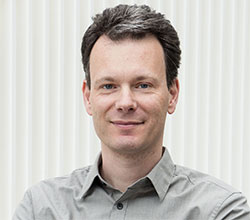
Technical Committees are the pulse of the Society's technical activities, responsible for everything from soliciting nominations for awards, to appointing Subcommittee members, to reviewing papers for SPS conferences. Each of SPS's 13 Technical Committees represent one of signal processing's diverse fields of interest, offering members and the greater signal processing community the opportunity to connect and collaborate with professionals with similar interests.
In our TC Spotlight series, we speak to Technical Committee members to learn about their experiences in the field, the impact of their work, and their involvement with the Society. Learn more about Technical Committee membership.
SPS TC Spotlight - Erik Meijering
 Erik Meijering, the current Chair of SPS’s Bio Imaging and Signal Processing (BISP) Technical Committee, has been pursuing his passion in signal processing from the onset of his education. Realizing early on the vast and evolving ways that signal processing can unlock solutions for the advancement of technology, Erik’s studies began in digital image processing and eventually focused on applications in biomedical imaging for his PhD. His involvement with IEEE first started in 2002 by volunteering to help organize the first IEEE ISBI Symposium, and over a decade later, as the 2018-2019 BISP TC Chair and new IEEE Fellow (class of 2019), he’s become a dedicated leader and a valued participant of the SPS community.
Erik Meijering, the current Chair of SPS’s Bio Imaging and Signal Processing (BISP) Technical Committee, has been pursuing his passion in signal processing from the onset of his education. Realizing early on the vast and evolving ways that signal processing can unlock solutions for the advancement of technology, Erik’s studies began in digital image processing and eventually focused on applications in biomedical imaging for his PhD. His involvement with IEEE first started in 2002 by volunteering to help organize the first IEEE ISBI Symposium, and over a decade later, as the 2018-2019 BISP TC Chair and new IEEE Fellow (class of 2019), he’s become a dedicated leader and a valued participant of the SPS community.
Erik was kind enough to sit down with us to answer, in-depth, a few questions about his background and career in signal processing, as well as his take on the bioimaging field and the topics emerging from it.
How did you first enter the signal processing field?
While studying electrical engineering I got in touch with the signal processing field very early on. I vividly remember the sense of wonder as an undergraduate student when I learned that under certain simple conditions, any continuous signal can be sampled to obtain a discrete signal that completely represents the original with zero (or minimal) loss of information, allowing digital processing of pretty much any real-world signal using computers. This matched perfectly with my passion as a computer programmer since my early teenage years. From then on I focused more and more on digital signal processing, in particular digital image processing. By the time I started working on my PhD, I had also developed a fascination for the field of biomedical imaging and the great challenge to improve the accuracy and efficiency of diagnostic and therapeutic procedures. This started my now 20+ year career in biomedical image computing.
How did you first become involved with the IEEE Signal Processing Society?
As a fresh postdoc I helped organizing the first IEEE International Symposium on Biomedical Imaging (ISBI), initiated by the Signal Processing Society (SPS) together with the Engineering in Medicine and Biology Society (EMBS). Soon after, I signed up as a member of both societies and continued being involved in subsequent editions of ISBI. It was a great experience that helped me get a much more complete picture of the field, the state of the art, and the challenges lying ahead. And it was a great opportunity to connect with many experts in the field and learn from them. My current research focus on microscopic image analysis, for example, was definitely inspired by people around me in the early years of my career who foresaw the great data explosion coming in that area. It is safe to say that I would not be where I am today, had I not taken that first step to join the IEEE SPS and volunteer in its activities.
What are some of the real-world applications and consumer devices that utilize your TC's technical areas?
The Bio Imaging and Signal Processing Technical Committee (BISP TC) covers the broad technical areas of computational image and signal processing with a clear focus on applications in biology and medicine. Countless devices are utilized worldwide every day in medical centers, for example, to help diagnose patients and determine the right therapy for them. Modern computed tomography (CT), magnetic resonance imaging (MRI), and ultrasound scanners are full of clever image and signal processing algorithms to produce high-fidelity pictures. But biological research, too, depends heavily on smart imaging and sequencing devices these days. A striking example is super-resolution microscopy, where robust particle detection and visualization techniques play an integral role in creating stunningly detailed images. And that is just the beginning. The sheer volume of the data produced by such devices precludes manual analysis by humans and requires powerful computational methods to allow automated extraction of accurate and complete information from the data. The BISP TC fosters the development and dissemination of such methods.
What is one emerging topic or signal processing technology in your TC’s scope that people should know about right now?
Machine learning technologies, in particular deep learning using artificial neural networks, are currently taking the world by storm, outperforming "classical" image and signal processing methods in many tasks. I have been around in the field long enough to have witnessed multiple technological waves come and go, but without a doubt this one is going to be the most far reaching yet. It is very exciting and very concerning at the same time. Exciting because deep learning is a generic technology that can solve a wide range of data processing problems very successfully and relatively easily. And concerning because for any given problem we often do not know exactly why. Intellectually this should be seen as a challenge rather than a concern. Indeed, many open research questions remain, such as how to optimally train a deep neural network in applications where little labeled data is available, or how to make a network trained for one application work for another with minimal extra effort. But practically, the current lack of interpretability of the decisions made by deep neural networks is very concerning in areas such as medical diagnostics, where accountability is important and decisions may have legal implications. These issues are food for scientific and ethical thought for years to come.
What advice would you give young engineers exploring a career in signal processing?
If you have not yet made up your mind, by all means do go for a career in signal processing. These are thrilling times, with more opportunities than ever before, in universities and companies alike. But whether you aspire a career in academia or in industry, it is important to get involved in professional networks and activities in the field. It puts your everyday work in a broader perspective, keeps you more aware of ongoing trends, allows you to actively contribute to and benefit from them, and likely opens doors in new directions you would have never imagined. An easy way to start is to sign up as an affiliate member of one of the SPS Technical Committees, such as the BISP TC, and volunteering to serve in its subcommittees and activities. The journey of a long career starts with taking one step.
